class ClassName
{
field1
field2
. . .
constructor1
constructor2
. . .
method1
method2
. . .
}Core Java. Лекция 3
Classes. Interfaces. Records. Enums
@inponomarev
Иван Пономарёв, КУРС/МФТИ

Everything is a class
Any code is a method of some class
Any data is stored in fields of some class
Any data type (except primitives, but including arrays) are inherited from the
Objectclass
Classes are located in packages
edu.phystech.fooedu.phystech.foo.barEach .java file starts with a package declaration:
package edu.phystech.hello;In the package directory can be
package-info.java, containing no classes, but only JavaDoc above thepackagekeyword.<Package Name>.<classname> specifies the full identifier of any class available in your source code or from libraries (for example,
edu.phystech.hello.App)Nested packages are different packages in Java (package-private classes of one package will not be visible in another)
Class structure: variables, constructors, and methods
Define a class
package org.megacompany.staff;
class Employee {
// instance fields
private String name;
private double salary;
private LocalDate hireDay;
// constructor
public Employee(String n, double s, int year, int month, int day) {
name = n;
salary = s;
hireDay = LocalDate.of(year, month, day);
}
// a method
public String getName() {
return name;
}
// more methods
. . .
}Create and use instances of the class
//If necessary, we can import a class from another package
import org.megacompany.staff.Employee;
//somewhere in the body of the method
. . .
Employee hacker = new Employee("Harry Hacker", 50000, 1989, 10, 1);
Employee tester = new Employee("Tommy Tester", 40000, 1990, 3, 15);
hacker.getName(); //returns "Harry Hacker"Field initialization
Unlike local variables, fields can miss explicit initialization.
In this case, primitive types are set to a default value (
0,false), and fields with references are set tonull.It is not forbidden to initialize the field at the place of its definition:
int a = 42or evenint a = getValue().
this field
{ ...
int value;
setValue(int value) {
// the field is hidden by an argument
this.value = value;
}
registerMe(Registrator r) {
// a link to oneself is needed
r.register(this);
}
}Objects are passed by reference!
public class Employee {
int age = 18;
public static void main(String[] args) {
Employee e = new Employee();
int a = 1;
foo(e, a);
System.out.printf("%d - %d", e.age, a);
//prints 42 - 1
}
static void foo(Employee e, int a) {
//e passed by reference, a passed by value
e.age = 42;
a = 5;
}
}Birth, life and death of an object
new Employee("Bob")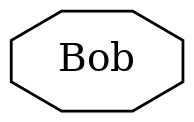
Reference assignment
Employee hacker = new Employee("Bob");
Reference assignment
Employee junior = hacker;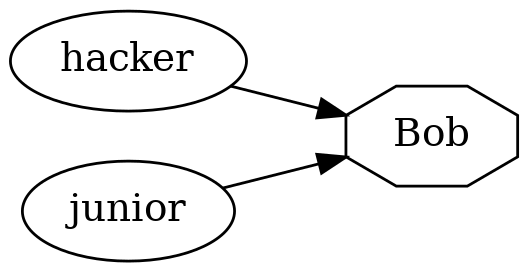
Reference loss
hacker = null;
junior = new Employee("Charlie");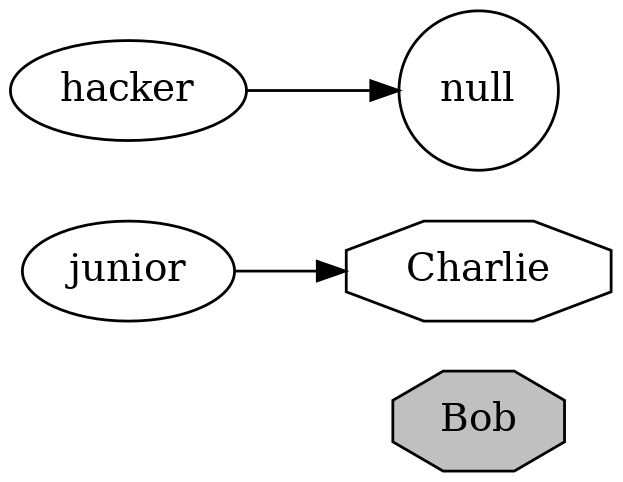
Garbage collection
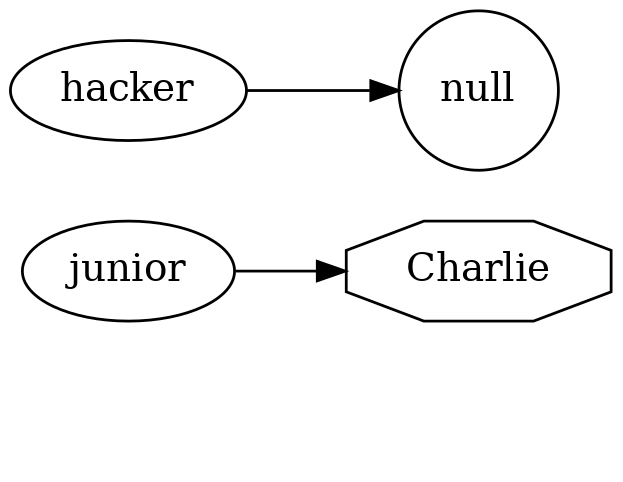
Scopes
Scope | Visibility |
| class only |
package-private | package only (default) |
| class, package, and descendant classes |
| everywhere |
Source code files and classes
In a .java file, there can be only one public class, named the same as the .java file ('public class Foo' in the 'Foo.java' file).
There can be as many package-private classes as you like, but this is rather a bad practice.
Inheritance
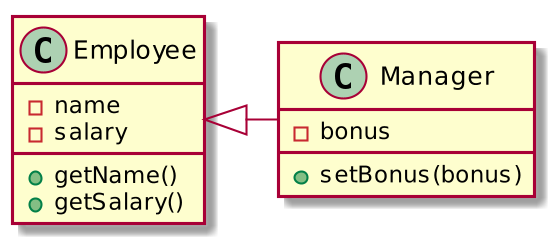
public class Manager extends Employee {
private double bonus;
. . .
public void setBonus(double bonus) {
this.bonus = bonus;
}
}Inheritance
// construct a Manager object
Manager boss = new Manager("Carl Cracker", 80000, 1987, 12, 15);
boss.setBonus(5000);
Employee[] staff = new Employee[3];
staff[0] = boss;
staff[1] = new Employee("Harry Hacker", 50000, 1989, 10, 1);
staff[2] = new Employee("Tommy Tester", 40000, 1990, 3, 15);
for (Employee e : staff)
System.out.println("name=" + e.getName() + ",salary=" + e.getSalary());Inheritance: Single parent class
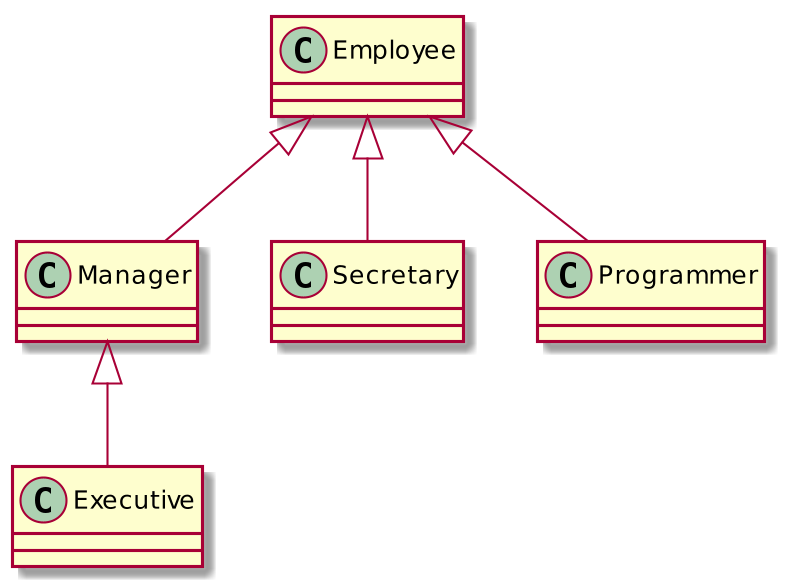
Reference type and object type

Executive ex = new Executive (...);
// members declared in Manager, Employee, and Executive are available for ex
Manager m = ex;
// members declared in Employee and Manager are available for m
Employee e = m;
// members declared in Employee only are available for mOverriding methods
class Employee {
private int salary;
public int getSalary() {
return salary;
}
public int getTotalPayout(){
return getSalary();
}
}
class Manager extends Employee {
private int bonus;
@Override //this is not mandatory, but highly desirable thing
public int getTotalPayout() {
return getSalary() + bonus;
}
}Using super
class Manager extends Employee {
private int bonus;
@Override
public int getTotalPayout() {
return super.getTotalPayout() + bonus;
}
}Unlike this, super does not point to any object (and cannot be passed as an argument). It just tells the compiler to call the superclass method.
Covariance of return types
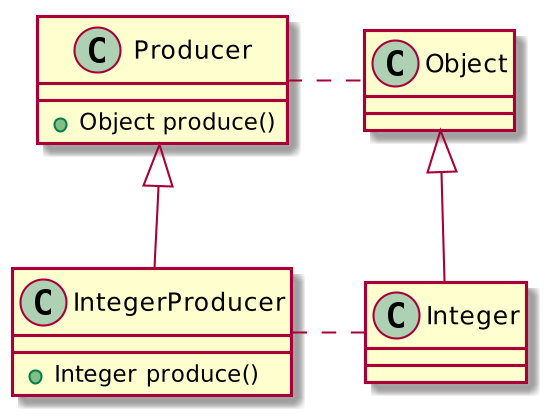
The return type can be of the same type or subtype
Argument types must match
final classes and methods
finalkeyword:at the class level prohibits class inheritance
at the method level prohibit method inheritance
Why?
"Template method pattern"
J. Bloch: 'Design and document for inheritance, or else prohibit it'
sealed types (Java 15+)
A sealed class be subclassed, but only by those who explicitly allowed to:
public sealed class Pet
permits
//no others may inherit from Pet
Cat, Dog, Fish {
}
public final Cat {...}
public sealed Dog permits Hound, Terrier, Toy {...}
public non-sealed Fish {...}Important example: sealed interfaces and `record`s
We don’t know what interface or record is yet, but just remember:
public sealed interface Expr
permits Add, Subtract, Multiply, Divide, Literal {}
//implicitly final!
public record Add(Expr left, Expr right) implements Expr {}
public record Subtract(Expr left, Expr right) implements Expr {}
public record Multiply(Expr left, Expr right) implements Expr {}
public record Divide(Expr left, Expr right) implements Expr {}
public record Literal(int value) implements Expr {}Overloading methods
Method signature is defined by its name and argument types:
//org.junit.jupiter.api.Assertions
void assertEquals(short expected, short actual)
void assertEquals(short expected, short actual, String message)
void assertEquals(short expected, short actual, Supplier<String> messageSupplier)
void assertEquals(byte expected, byte actual)
void assertEquals(byte expected, byte actual, String message)
void assertEquals(byte expected, byte actual, Supplier<String> messageSupplier)
void assertEquals(int expected, int actual)
void assertEquals(int expected, int actual, String message)
void assertEquals(int expected, int actual, Supplier<String> messageSupplier)
. . .Static fields and methods
Data common to all instances of the class:
class Employee {
/*WARNING: This example
does not work in multi-threaded environment*/
private static int nextId = 1;
private int id;
. . .
public void setId() {
id = nextId;
nextId++;
}
}Static constants
Allocate memory once
public class Math {
. . .
public static final double PI = 3.14159265358979323846;
. . .
}
. . .
Math.PI // returns 3.14...Static methods
Only static variables and other static methods are available to static methods
class Employee {
private static int nextId = 1;
private int id;
. . .
public static int getNextId() {
return nextId; // returns static field
}
}
. . .
Employee.nextId() //class name instead of objectpsvm
Now we understand: the main method is available everywhere and does not require instantiation of the object:
public class App {
public static void main(String... args) {
System.out.println("Hello, world!");
}
}Constructor
public class Person {
//public constructor without arguments
public Person() {
....
}
//package-private constructor with argument
Person(String name) {
....
}
}Constructors
The constructor must exist.
If we don’t 1) explicitly write a constructor, 2) the parent class has a constructor without arguments — then implicitly the class will have a public constructor with no default arguments.
If we explicitly wrote at least one constructor, the default constructor disappears.
If the parent class does not have a constructor without arguments, the default constructor is not created.
Constructor does not have to be public.
Overriding constructors when inheriting classes
До Java25: если у суперкласса нет конструктора без аргументов, первым вызовом должен был быть
super(…).После Java25: пишем как угодно, главное в конструкторе субдкласса не брать значения не проинстанцированных полей суперкласса.
public class Person {
Person(String name){
...
}
}
class Employee extends Person{
Employee(String name) {
super(name);
...
}
}Overloading constructors
'this(…) ` call
Java 25+: свобода в плане того, где он может быть вызван.
public class Person {
Person(String name){
...
}
Person(){
this("unknown");
}
}Initialization sections
class Employee {
private static int nextId;
private int id;
// static initialization block
static {
nextId = ThreadLocalRandom.current().nextInt(10000);
}
// object initialization block
{
id = nextId;
nextId++;
}
}What about the destructor?
There are no destructors!
Don’t even try to use 'finalize'
Why the
finalizemethod was a bad idea?
Nested classes
class Outer {
int field = 42;
class Inner {
public void show() {
//there is an access to the external class's state!
System.out.println(field);
//prints 42
}
}
void initInner(){
// initialization of the nested class inside the outer class
new Inner();
}
}
//initialization of a nested outside the outer class
Outer.Inner in = new Outer().new Inner();Nested classes
Each instance of Inner has an implicit reference to Outer.
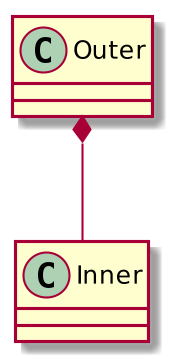
Nested classes
class Outer {
int field = 42;
class Inner {
//nested class field hides external class field
int field = 18;
public void show() {
System.out.println(field);
//prints 18
}
}
}Nested classes
class Outer {
int field = 42;
class Inner {
//nested class field hides external class field
int field = 18;
public void show() {
System.out.println(Outer.this.field);
//prints 42!
}
}
}Local nested classes
class Outer {
void outerMethod() {
//final (or effectively final) here matters!
final int x = 98;
System.out.println("inside outerMethod");
class Inner {
void innerMethod() {
System.out.println("x = " + x);
}
}
Inner y = new Inner();
y.innerMethod();
}
}Java 15+: локальные record-ы, enum-ы и интерфейсы
class Outer {
void outerMethod() {
//they do not capture the external state
record Foo (int a, int b) {};
enum Bar {A, B};
interface Baz {};
//NB:
//static not allowed here!
static class X {};
}
}Nested static classes
In fact, they are no different from just classes:
class Outer {
private static void outerMethod() {
System.out.println("inside outerMethod");
}
static class Inner {
public static void main(String[] args) {
System.out.println("inside inner class Method");
outerMethod();
}
}
}
. . .
Outer.Inner x = new Outer.Inner();
//unlike non-static new Outer().new Inner();Anonymous classes
class Demo {
void show() {
System.out.println("superclass");
}
}
class Flavor1Demo {
public static void main(String[] args){
Demo d = new Demo() {
void show() {
super.show();
System.out.println("subclass");
}
};
d.show();
}
}Using Anonymous Classes
Most often - as an implementation of abstract classes and interfaces "in place"
An anonymous class is a nested class, so before the introduction of lambdas and method references, this was the only way to organize a callback
. . .
button.onMouseClick(new EventListener(){
void onClick(Event e) {
//here we have access to all external fields
//and effectively final-variables
}
});Abstract classes and methods
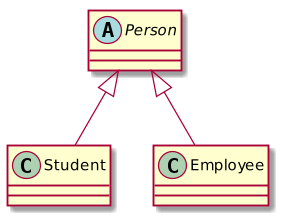
public abstract class Person
{
public Person(String name) {
this.name = name;
}
public String getName() {
return name;
}
public abstract String getDescription();
}Abstract class implementation
public class Student extends Person
{
private String major;
public Student(String name, String major) {
super(name);
this.major = major;
}
@Override
public String getDescription() {
return "a student majoring in " + major;
}
}Rules
A class in which at least one of the methods is not implemented must be marked as
abstractUnimplemented methods in a class occur in two ways:
explicitly declared as
abstractInherited from abstract classes or interfaces and not overridden.
Abstract classes cannot be instantiated through
newoperator.new Person('John Doe');— compilation error: 'Person is abstract, cannot be instantiated'.
Interfaces
//его нельзя инстанцировать!
public interface Prism
{
//это --- final-переменная!
double PI = 3.14;
//these are public abstract methods!
double getArea();
double getHeight();
//this method can call other methods and read constants
default double getVolume() {
return getArea() * getHeight();
}
}Interface implementation
public class Parallelepiped implements Prism {
private double a;
private double b;
private double h;
@Override
public double getArea() {
return a * b;
}
@Override
public double getHeight() {
return h;
}
}If any of the interface methods are not overridden, the class should be marked as abstract.
How are interfaces different from abstract classes?
No internal state and constructors
You can inherit (via
extends) from only one class, but implement (viaimplements) as many interfaces as you want — multiple inheritance.Therefore, as an abstraction, the interface is preferred.
Специальные виды типов
Enumeration Classes
Records
Annotation Interfaces (о них речь пойдёт значительно позже)
Enumeration Classes (Java 5+)
public enum Size
{ SMALL, MEDIUM, LARGE, EXTRA_LARGE };
. . .
Size s = Size.MEDIUM;
for (Size s: Size.values()) . . .
switch (s) {
case SMALL: . . .
case LARGE: . . .
}Поля, методы и конструкторы для перечислений
public enum Size
{
SMALL("S"), MEDIUM("M"), LARGE("L"), EXTRA_LARGE("XL");
private final String abbreviation;
private Size(String abbreviation) {
this.abbreviation = abbreviation;
}
public String getAbbreviation() {
return abbreviation;
}
}
. . .
Size s = . . .
s.getAbbreviation(); // вернёт S, M, L или XLEnums: интерфейсы и абстрактные методы
interface Rule { boolean canGo(); }
enum TrafficLight implements Rule {
RED {
@Override public boolean canGo() { return false; }
@Override int durationSeconds() { return 55; }
},
YELLOW {
@Override public boolean canGo() { return false; }
@Override int durationSeconds() { return 5; }
},
GREEN {
@Override public boolean canGo() { return true; }
@Override int durationSeconds() { return 45; }
};
// Abstract method implemented individually by each constant
abstract int durationSeconds();
}Records (Java 16+)
Иммутабельные объекты (один раз создав, нельзя менять состояние)
Компактный синтаксис
Наследование запрещено, но можно реализовывать интерфейс
Автоматическая поддержка
equals/hashCode(что это, мы узнаем вскоре).
//Defines a record with two int fields
public record Point(int x, int y) { }Records
public record Point(int x, int y) {
public double distance(Point other) {
int dx = x - other.x;
int dy = y - other.y;
return Math.sqrt(dx * dx + dy * dy);
}
}
Point p1 = new Point(1, 2);
//Get value via implicit accessor method
System.out.println(p1.x());
System.out.println(p1.distance(new Point(3, 4)));Базовые принципы проектирования классов
Минимизируйте область видимости (
privateвсё, что только можно)Минимизируйте мутабельность (
finalна всём, что только можно)Документируйте точки расширения через наследование, или запрещайте наследование (
final,sealed)